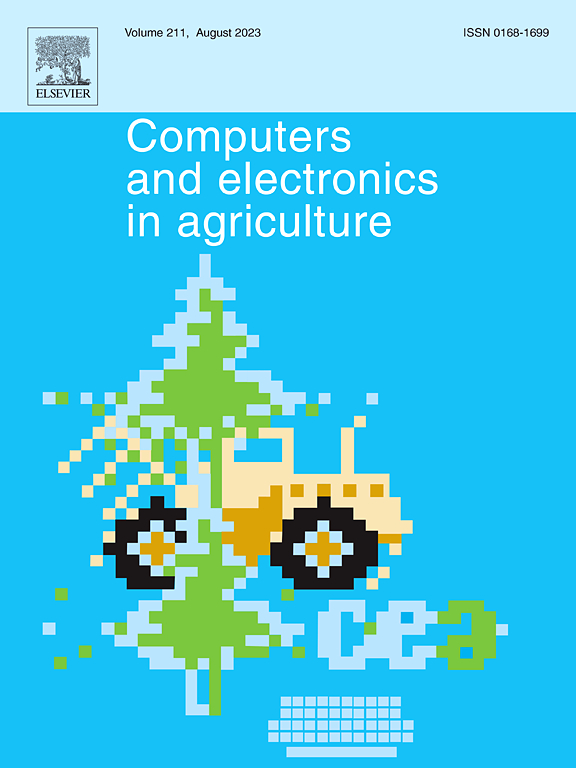基于深度学习和delta机器人系统的种薯切割机器人的设计与实现,具有高精度和高速度的自动化农产品加工
IF 7.7
1区 农林科学
Q1 AGRICULTURE, MULTIDISCIPLINARY
引用次数: 0
摘要
土豆、大米和大豆是世界上消费最广泛的主粮作物。传统上,种子土豆是手工切割的,由于需求不断增加,这影响了切割过程的一致性和效率。为了解决这个问题,我们开发并评估了一个自动切土豆机器人系统。该系统采用马铃薯方向检测你只看一次(POD-YOLO)深度学习模型来识别种子马铃薯的姿势、边界和关键眼睛位置。采用聚类分析与目标函数优化相结合的策略实现智能切割路径规划,并由Delta并联机器人进行切割。通过基于单应性矩阵的摄像机-机器人校准,可以实现精确的视觉引导。性能评估表明,静态视觉制导定位误差大多在±0.5 mm以内。所选择的切削策略在切削均匀性和切削覆盖率方面表现出较强的性能。圆形土豆的最大切割成功率为85%,系统的平均周期时间约为2.14秒,吞吐量约为418.8公斤/小时,大约是熟练手工工人的三倍。虽然结果验证了该系统的技术可行性,但仍存在一些挑战,包括单一视点导致的视觉数据不完整、输送机的动态定位误差以及使用单一切削工具的局限性。本研究提出了全面的解决方案和经验证据,突出了优化方向,包括多传感器融合、动态误差补偿和先进的切割机制。源代码在:https://github.com/Jie-Huangi/seed-potato-cutting-robot。本文章由计算机程序翻译,如有差异,请以英文原文为准。
Design and implementation of a seed potato cutting robot using deep learning and delta robotic system with accuracy and speed for automated processing of agricultural products
Potatoes, along with rice and soy, are among the most widely consumed staple crops worldwide. Seed potatoes are traditionally manually cut, affecting the consistency and efficiency of the process given ever-increasing demand. To address this problem, we developed and evaluated an automated potato cutting robot system. The system employs a Potato Orientation Detection You Only Look Once (POD-YOLO) deep learning model to identify the pose, boundaries, and key eye locations of seed potatoes. Intelligent cutting path planning is achieved through a strategy that combines clustering analysis with objective function optimization, and cutting is performed by a Delta parallel robot. Precise visual guidance is enabled through camera-robot calibration based on a homography matrix. Performance evaluation reveals that static visual guidance positioning errors are mostly within ±0.5 mm. The selected cutting strategy demonstrates strong performance in terms of cutting uniformity and coverage rate. A maximum cutting success rate of 85 % is achieved for round potatoes, and the system’s average cycle time is approximately 2.14 s, resulting in a throughput of about 418.8 kg/h, roughly three times that of a skilled manual labor. While the results validate the technical feasibility of the system, several challenges remain, including incomplete visual data due to a single viewpoint, dynamic positioning errors from the conveyor, and limitations of using a single-cutting tool. This research presents a comprehensive solution and empirical evidence, highlighting directions for optimization including multi-sensor fusion, dynamic error compensation, and advanced cutting mechanisms. The source codes are at: https://github.com/Jie-Huangi/seed-potato-cutting-robot.
求助全文
通过发布文献求助,成功后即可免费获取论文全文。
去求助
来源期刊

Computers and Electronics in Agriculture
工程技术-计算机:跨学科应用
CiteScore
15.30
自引率
14.50%
发文量
800
审稿时长
62 days
期刊介绍:
Computers and Electronics in Agriculture provides international coverage of advancements in computer hardware, software, electronic instrumentation, and control systems applied to agricultural challenges. Encompassing agronomy, horticulture, forestry, aquaculture, and animal farming, the journal publishes original papers, reviews, and applications notes. It explores the use of computers and electronics in plant or animal agricultural production, covering topics like agricultural soils, water, pests, controlled environments, and waste. The scope extends to on-farm post-harvest operations and relevant technologies, including artificial intelligence, sensors, machine vision, robotics, networking, and simulation modeling. Its companion journal, Smart Agricultural Technology, continues the focus on smart applications in production agriculture.
 求助内容:
求助内容: 应助结果提醒方式:
应助结果提醒方式:


